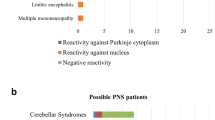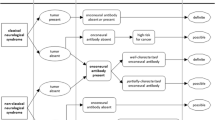Abstract
Purpose
We assessed the frequency and levels of onconeural antibodies in 974 patients with various types of tumours, but without apparent paraneoplastic neurological syndromes (PNS).
Patients and methods
We included patients with the following tumours: 200 small-cell lung cancer (SCLC) patients, 253 breast cancer patients, 182 ovarian cancer patients, 266 uterine cancer patients and 73 thymoma patients, as well as 52 patients with PNS and cancer and 300 healthy blood donors. Sera were screened for amphiphysin, CRMP5, Hu, Ma2, Ri and Yo antibodies using a multi-well immunoprecipitation technique.
Results
The most frequently detected antibodies were Hu followed by CRMP5. Ma2, Yo, amphiphysin and Ri antibodies were less common, but each was found at similar frequencies. Onconeural antibodies were present at similar levels in sera from the PNS control group and from cancer patients. Hu antibodies were rare in cancers other than SCLC. CRMP5 was the only antibody found in patients with thymoma and this antibody was more common among patients with thymoma than in other tumour patients. With one exception, coexisting antibodies were only found in patients with SCLC. The presence of onconeural antibodies in SCLC patients was not associated with prolonged survival.
Conclusion
Onconeural antibodies are associated with various types of tumours suggesting that all antibodies should be included in the serological screening for possible PNS. The levels of onconeural antibody are not sufficiently sensitive to discriminate between cancer patients with PNS and those without.



Similar content being viewed by others
References
Graus F, Dalmau J, Rene R, Tora M, Malats N, Verschuuren JJ, Cardenal F, Vinolas N, Garcia del Muro J, Vadell C, Mason WP, Rosell R, Posner JB, Real FX (1997) Anti-Hu antibodies in patients with small-cell lung cancer: association with complete response to therapy and improved survival. J Clin Oncol 15:2866–2872
Drlicek M, Bianchi G, Bogliun G, Casati B, Grisold W, Kolig C, Liszka-Setinek U, Marzorati L, Wondrusch E, Cavaletti G (1997) Antibodies of the anti-Yo and anti-Ri type in the absence of paraneoplastic neurological syndromes: a long-term survey of ovarian cancer patients. J Neurol 244:85–89
Pittock SJ, Kryzer TJ, Lennon VA (2004) Paraneoplastic antibodies coexist and predict cancer, not neurological syndrome. Ann Neurol 56:715–719
Monstad SE, Drivsholm L, Storstein A, Aarseth JH, Haugen M, Lang B, Vincent A, Vedeler CA (2004) Hu and voltage-gated calcium channel (VGCC) antibodies related to the prognosis of small-cell lung cancer. J Clin Oncol 22:795–800
Monstad SE, Storstein A, Dorum A, Knudsen A, Lonning PE, Salvesen HB, Aarseth JH, Vedeler CA (2006) Yo antibodies in ovarian and breast cancer patients detected by a sensitive immunoprecipitation technique. Clin Exp Immunol 144:53–58
Knudsen A, Monstad SE, Dorum A, Lonning PE, Salvesen HB, Drivsholm L, Aarseth JH, Vedeler CA (2006) Ri antibodies in patients with breast, ovarian or small cell lung cancer determined by a sensitive immunoprecipitation technique. Cancer Immunol Immunother 55:1280–1284
Monstad SE, Drivsholm L, Skeie GO, Aarseth JH, Vedeler CA (2008) CRMP5 antibodies in patients with small-cell lung cancer or thymoma. Cancer Immunol Immunother 57:227–232
Graus F, Delattre JY, Antoine JC, Dalmau J, Giometto B, Grisold W, Honnorat J, Smitt PS, Vedeler C, Verschuuren JJ, Vincent A, Voltz R (2004) Recommended diagnostic criteria for paraneoplastic neurological syndromes. J Neurol Neurosurg Psychiatry 75:1135–1140
Husebye ES, Gebre-Medhin G, Tuomi T, Perheentupa J, Landin-Olsson M, Gustafsson J, Rorsman F, Kampe O (1997) Autoantibodies against aromatic L-amino acid decarboxylase in autoimmune polyendocrine syndrome type I. J Clin Endocrinol Metab 82:147–150
Falorni A, Ortqvist E, Persson B, Lernmark A (1995) Radioimmunoassays for glutamic acid decarboxylase (GAD65) and GAD65 autoantibodies using 35S or 3H recombinant human ligands. J Immunol Methods 186:89–99
Falorni A, Nikoshkov A, Laureti S, Grenback E, Hulting AL, Casucci G, Santeusanio F, Brunetti P, Luthman H, Lernmark A (1995) High diagnostic accuracy for idiopathic Addison’s disease with a sensitive radiobinding assay for autoantibodies against recombinant human 21-hydroxylase. J Clin Endocrinol Metab 80:2752–2755
Ekwall O, Hedstrand H, Grimelius L, Haavik J, Perheentupa J, Gustafsson J, Husebye E, Kampe O, Rorsman F (1998) Identification of tryptophan hydroxylase as an intestinal autoantigen. Lancet 352:279–283
Bradwell AR (2000) Paraneoplastic neurological syndromes associated with Yo, Hu, and Ri autoantibodies. Clin Rev Allergy Immunol 19:19–29
Benyahia B, Amoura Z, Rousseau A, Le Clanche C, Carpentier A, Piette JC, Delattre JY (2003) Paraneoplastic antineuronal antibodies in patients with systemic autoimmune diseases. J Neurooncol 62:349–351
Vernino S, Lennon VA (2004) Autoantibody profiles and neurological correlations of thymoma. Clin Cancer Res 10:7270–7275
Graus F, Cordon-Cardo C, Posner JB (1985) Neuronal antinuclear antibody in sensory neuronopathy from lung cancer. Neurology 35:538–543
Yu Z, Kryzer TJ, Griesmann GE, Kim K, Benarroch EE, Lennon VA (2001) CRMP-5 neuronal autoantibody: marker of lung cancer and thymoma-related autoimmunity. Ann Neurol 49:146–154
Bataller L, Wade DF, Graus F, Stacey HD, Rosenfeld MR, Dalmau J (2004) Antibodies to Zic4 in paraneoplastic neurologic disorders and small-cell lung cancer. Neurology 62:778–782
Antoine JC, Absi L, Honnorat J, Boulesteix JM, de Brouker T, Vial C, Butler M, De Camilli P, Michel D (1999) Antiamphiphysin antibodies are associated with various paraneoplastic neurological syndromes and tumors. Arch Neurol 56:172–177
Pittock SJ, Lucchinetti CF, Parisi JE, Benarroch EE, Mokri B, Stephan CL, Kim KK, Kilimann MW, Lennon VA (2005) Amphiphysin autoimmunity: paraneoplastic accompaniments. Ann Neurol 58:96–107
Saiz A, Dalmau J, Butler MH, Chen Q, Delattre JY, De Camilli P, Graus F (1999) Anti-amphiphysin I antibodies in patients with paraneoplastic neurological disorders associated with small cell lung carcinoma. J Neurol Neurosurg Psychiatry 66:214–217
Peterson K, Rosenblum MK, Kotanides H, Posner JB (1992) Paraneoplastic cerebellar degeneration. I. A clinical analysis of 55 anti-Yo antibody-positive patients. Neurology 42:1931–1937
Pittock SJ, Lucchinetti CF, Lennon VA (2003) Anti-neuronal nuclear autoantibody type 2: paraneoplastic accompaniments. Ann Neurol 53:580–587
Voltz R, Gultekin SH, Rosenfeld MR, Gerstner E, Eichen J, Posner JB, Dalmau J (1999) A serologic marker of paraneoplastic limbic and brain-stem encephalitis in patients with testicular cancer. N Engl J Med 340:1788–1795
Acknowledgments
We thank Kibret Mazengia and Emilia Lohndal, University of Bergen, for technical help. We also thank Lars Drivsholm, Storstrømmens Hospital, Per E. Lønning and Geir O. Skeie, Haukeland University Hospital, for sera and clinical information regarding the different tumour patients. This study was supported by grants from the Western Norway Regional Health Authority (Helse Vest) and the University of Bergen, Norway.
Author information
Authors and Affiliations
Corresponding author
Rights and permissions
About this article
Cite this article
Monstad, S.E., Knudsen, A., Salvesen, H.B. et al. Onconeural antibodies in sera from patients with various types of tumours. Cancer Immunol Immunother 58, 1795–1800 (2009). https://doi.org/10.1007/s00262-009-0690-y
Received:
Accepted:
Published:
Issue Date:
DOI: https://doi.org/10.1007/s00262-009-0690-y




